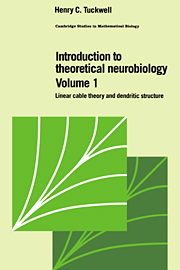Book contents
- Frontmatter
- Contents
- Preface
- 1 Introductory neuroanatomy and neurophysiology: the properties of motoneurons
- 2 The classical theory of membrane potentials
- 3 The Lapicque model of the nerve cell
- 4 Linear cable theory for nerve cylinders and dendritic trees: steady-state solutions
- 5 Time-dependent cable theory for nerve cylinders and dendritic trees
- 6 Rail's model neuron
- References
- Index
4 - Linear cable theory for nerve cylinders and dendritic trees: steady-state solutions
Published online by Cambridge University Press: 29 December 2009
- Frontmatter
- Contents
- Preface
- 1 Introductory neuroanatomy and neurophysiology: the properties of motoneurons
- 2 The classical theory of membrane potentials
- 3 The Lapicque model of the nerve cell
- 4 Linear cable theory for nerve cylinders and dendritic trees: steady-state solutions
- 5 Time-dependent cable theory for nerve cylinders and dendritic trees
- 6 Rail's model neuron
- References
- Index
Summary
Introduction
In Chapter 3 the Lapicque model, in which a lumped circuit consisting of a resistance and capacitance in parallel, was employed to represent the entire nerve cell. Though that simple model is not without usefulness, when we cast our minds back to the anatomical facts we reviewed concerning motoneurons in Chapter 1, we realize that we must extend the model if we wish to incorporate the realities of neuronal structure.
For example, we might ask what is the relative effectiveness of synapses close to the soma, compared to those of the same strength on distal parts of the dendritic tree. Or we might wish to inquire how branching affects the integration of various inputs. The model developed in this chapter will help us answer these kinds of questions within a mathematical framework, which is not conceptually difficult, though it has a cumbersome nature when the geometry of the cell is complicated. The various portions of the dendritic tree and the axon are now regarded as passive nerve cylinders and the equations satisfied by the electric potential are the partial differential equations of linear cable theory. (The term passive here means that the membrane conductance is fixed.)
We will here bridge the gap between the simple lumped-circuit model of Chapter 3 and the more complicated Hodgkin–Huxley model considered later. It must be emphasized that in this chapter and the next we deal only with subthreshold responses: that is, levels of excitation less than those required to generate action potentials.
- Type
- Chapter
- Information
- Introduction to Theoretical Neurobiology , pp. 124 - 179Publisher: Cambridge University PressPrint publication year: 1988
- 2
- Cited by



